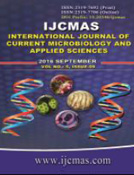


 National Academy of Agricultural Sciences (NAAS)
National Academy of Agricultural Sciences (NAAS)

|
PRINT ISSN : 2319-7692
Online ISSN : 2319-7706 Issues : 12 per year Publisher : Excellent Publishers Email : editorijcmas@gmail.com / submit@ijcmas.com Editor-in-chief: Dr.M.Prakash Index Copernicus ICV 2018: 95.39 NAAS RATING 2020: 5.38 |
Aquatic insects biodiversity is being increasingly imperilled by a range of factors globally. Freshwater aquatic insects inhabit river and stream beds, lakes and reservoirs and are associated with various types of substrates such as mineral sediments, detritus, macrophytes and filamentous algae. The distribution of aquatic organisms is the result of interactions among their ecological role, the physical conditions that characterize the habitat, and food availability. Biodiversity is not only the richness of species; it is also their genetic variety and the multiple habitats and ecosystems in which these plants and animals live. Ecosystems contain both the living plants and animals and the nonliving elements (water, sunlight, soils) on which they depend. At high altitudes, insects are the dominant animals. Insects successfully dominant almost every conceivable habitat and flourish at the highest limits of existence of animal life. The high altitude insects are an ecologically highly specialized group of mountain autochthonous species. Insects have the broad range of adaptation and can survive in the extreme environmental conditions, prevailing at high altitudes such as in Himachal Pradesh.
 |
 |
 |
 |
 |